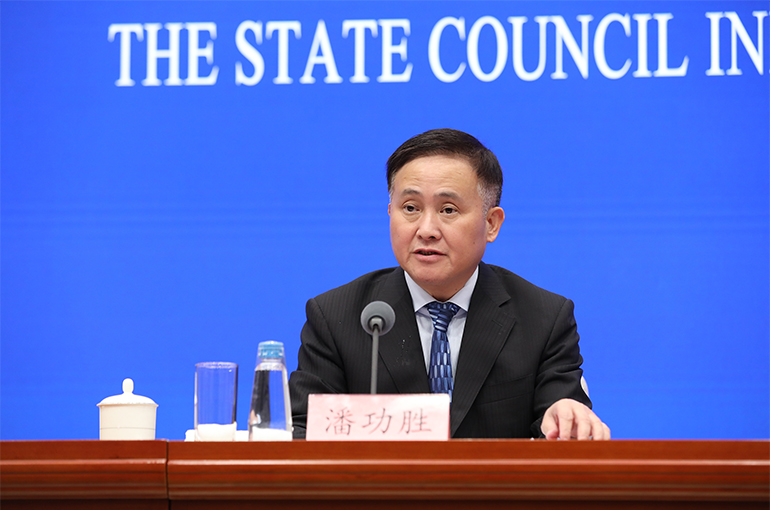 China to Trim Mortgage Rates in Big Property Market Support Package
China to Trim Mortgage Rates in Big Property Market Support Package(Yicai) Sept. 24 -- China unveiled a big support package to bolster the country’s sluggish real estate market, including lowering interest rates on existing mortgages by about 0.5 percentage point and reducing the minimum down payment for second home loans.
The People’s Bank of China will guide commercial lenders to cut rates on existing mortgages to around those on new home loans, Governor Pan Gongsheng announced this morning. That could benefit about 50 million households by shaving about CNY150 billion (USD21.3 billion) off their interest payments, he noted.
New stimulus measures to help the world’s second-largest economy reach its annual growth target of around 5 percent had been widely expected after key economic indicators softened further last month.
China’s stock market benchmarks soared after the full package was set out. The Shanghai Composite Index [SHA: 000001] ended 4.2 percent higher, while the Shanghai Stock Exchange Star 50 [SHA: 000688] gained 3.7 percent. The Shenzhen Component Index [SHE: 399001] added 4.4 percent, and the tech heavy ChiNext Index [SHE: 399006] 5.5 percent.
Pan said the central bank will publish an official document soon, but it will take time to implement the changes because “there are so many people involved in this matter, and banks also need some time for the necessary technical preparations.”
Regarding the operational details, he noted that lenders will initially transfer the mortgages in-house and then consider whether inter-bank transfers are needed.
The average mortgage rate for first-time home buyers in 30 key Chinese cities is 3.21 percent, while that for second home loans is 3.53 percent, according to data from real estate information provider CRIC China. That compares with an average 4 percent for existing mortgages, suggesting a substantial potential reduction under the central bank's new policy.
The high rates on existing mortgages are mainly shouldered by property owners who bought between 2017 and 2021, Li Yujia, chief researcher at the Center for Housing Policy Studies of the Guangdong Urban & Rural Planning and Design Institute, told Yicai. Many of them are young people and new urban residents who moved to cities in the last urbanization boom, as well as some property investors who were stuck in the market frenzy of the period, he said.
With property prices having fallen back to around 2017 levels and negative factors from slower economic growth, lower rates could help alleviate some of the financial pressure on these groups, Li noted.
If rates drop by 50 basis points, that could save each mortgage holder CNY300 (USD42.60) a month based on a CNY1 million (USD142,100) 30-year home loan, Yan Yuejin, deputy director of the E-House Real Estate Research Institute in Shanghai, pointed out.
Down Payments Eased
As part of the support package, Pan also announced that the PBOC will ease the minimum down-payment ratio on second home purchases from 25 percent to 15 percent, making it the same as for first homes.
“Real estate market conditions vary greatly between regions, so local governments need to adopt differentiated arrangements and set the minimum down payment ratio in their jurisdictions based on the national baseline,” Pan pointed out.
Banks can also negotiate with customers to determine the ratio based on their risk profiles and preferences, he said.
That could stimulate more demand from home owners seeking to move up the property ladder, Yan noted, pointing out that for a family buying a CNY2 million second home, the down payment ratio would have been CNY500,000 (USD71,050), but under the new policy it will be CNY300,000.
A marketing executive at a Shenzhen property developer told Yicai that these two new policies will help boost market confidence and release new demand.
RRR, Other Rates Cut
Pan also revealed a 50 basis points cut to the reserve requirement ratio, or the amount of cash that lenders are required to hold in reserve, to free up about CNY1 trillion (USD142.1 billion) of long-term liquidity. The PBOC may further cut the RRR by 25 bps to 50 bps later this year, he noted.
And the PBOC trimmed the seven-day reverse repurchase rate by 20 bps to 1.5 percent. The benchmark loan prime rate and deposit rates were also pared by the same amount to keep net interest rate spread stable at commercial banks.
Seperately, the PBOC announced that it will create new monetary policy tools to support the stock market’s steady development. It will introduce swap facilities for brokerages, funds, and insurers so they can access central bank liquidity by pledging assets, thereby enhancing their ability to secure funds and lift their stock holdings.
A special re-landing plan will also be implemented to guide lenders in providing loans to listed companies and major shareholders to support stock repurchases and shareholding increases.
Editors: Liao Shumin, Tang Shihua, Futura Constaglione, Tom Litting